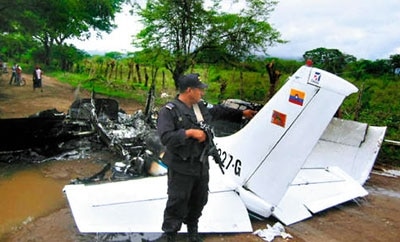Since the removal of US radar technology last month, Honduras has been made more vulnerable to a growing number of drug flights. Coupled with recent data showing the country’s homicide rate at 91 per 100,000 last year, this Central American nation is sliding further into the hands of organized crime.
Ramon Custodio, the head of Honduras’ human rights commission (known by its acronym CONADEH), announced that drug trafficking flights passing through Honduras have increased by some 89 percent in the last year.
According to Custodio, the country’s location at the heart of the Central American isthmus — the principal trafficking route for US-bound cocaine — coupled with the installation last October of a radar in the Dominican Republic to monitor drug flights, has meant traffickers are increasingly turning to Honduran air space to move cocaine from South America.
Exacerbating this further was the decision by the US to remove its radar technology from the country on August 18 due to the unilateral action by the Honduran Air Force in shooting down two suspected drug flights in July. This was not only in contravention of Honduran law and but also an agreement the country has with the US. The decision led Custodio to declare Honduras as being “open skies for drug trafficking.”
The US ambassador to Honduras, Lisa Kubiske, stated that the US will re-install the radar technology soon. However, Honduras has already begun receiving offers from other countries for technological assistance, including radar. Leading the way are Brazil and Israel, reported La Prensa, though Spain, France, Argentina and Holland have all offered aid as well.
Defense Minister Marlon Pascua underscored the need for technological aid from outside, telling press that much of the country’s existing equipment to combat drug trafficking is outdated, reported Prensa Libre. “The boats [that we have] are over 40 years old and the aircraft date back to the 1980s,” he lamented.
InSight Crime Analysis
Many of the Hondruan media outlets reported that, prior to the 89 percent increase, the country served as a transit point for 26 percent of cocaine flights coming from South America. This is likely an underestimation, with the US State Department stating the figure to be 79 percent in its 2012 International Narcotics Control Strategy Report, making Custodio’s assertion all the more alarming.
While Custodio’s reasoning behind the rise is accurate, it omits some crucial country-specific factors which make Honduras such a key transhipment point for drug flights. The removal of US radar technology has doubtless hurt the country, though the endemic levels of police corruption and a deteriorating security situation also make it an ideal option for traffickers. The National Congress’ vice president, Marvin Ponce, declared last July that some 40 percent of the country’s police force had ties to organized crime. Compounding this are recently released statistics by the Organization of American States (OAS) showing that the country’s homicide rate for 2011 was 91.6 per 100,000 inhabitants, a jump from 51 per 100,000 in 2000. The United Nations’ estimate is 86 per 100,000. Either figure makes Honduras one of the world’s most deadly nations.
While Honduras’ security situation over the last decade has been precarious, the 2009 coup threw the country into a state of further insecurity from which it shows no signs of being able to exit. This, in conjunction with weak and corrupt security forces, has been detrimental to the aid received from international donors. The US have been at the forefront of counter-narcotics assistance, but this is far from unconditional. This has been shown not only by the removal of radar intelligence, but also with the suspension of aid to police units under the command of the new police chief, Juan Carlos Bonilla, due to claims he previously ran death squads.
As Central America’s second poorest country after Nicaragua, Honduras lacks resources to purchase its own equipment. As InSight Crime noted at the beginning of 2012, Honduras’ outlook was dim. With reported increases in drug trafficking activity and homicide levels, things just got a little bleaker.

